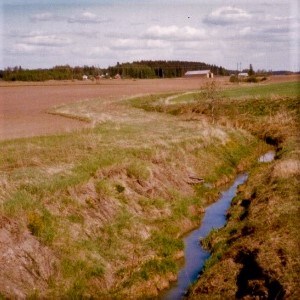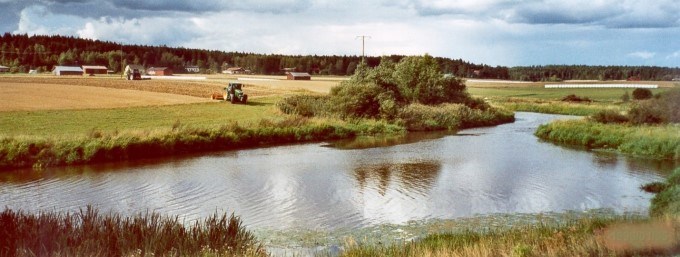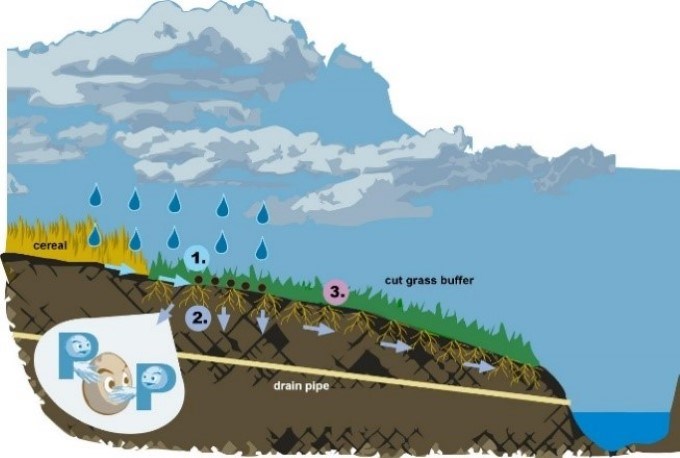Buffer zones along waters

Buffer zones (BZs) between pollutant source area and receiving waters is a supplementary measure to prevent runoff of sediments, nutrients and other pollutants.
A buffer zone with permanent vegetation cover locates generally between an agricultural field and a receiving water body or main ditch having several benefits. The BZ prevents the application of fertilizers, manure, and pesticides too close to an adjacent water body, brook, or main ditch since these operations as well as soil tillage are not allowed in BZs. It not only controls erosion on the slope but also removes sediment, nutrients, and other pollutants from surface runoff. In addition, the BZ enhances the biodiversity and especially can increase the number of pollinators.
Buffer zones can control loading in several ways. Firstly, dense vegetation in the BZ increases the hydraulic roughness reducing the overland flow velocity and sediment transport capacity. At the same time, eroded soil particles are settled in the BZ and particle bound nutrients and pollutants are retained. Secondly, phosphorus is adsorbed in the soil surface whereas soluble nutrients and compounds infiltrate with runoff water into the ground. Thirdly, the vegetation in the BZ adsorbs pollutants from the surface runoff and roots take up nutrients from the soil.
Localisation and implementation
Buffer zones are generally established between lower field edges and main ditches or water bodies, but more than one edge may also be buffered in the same field. The width of BZ depends on the erodibility of the protected field and slope. The longer, steeper or more erodibility the slope, the wider BZ is needed. A narrow headland is enough along the main ditches or a 3-m-wide buffer strip along brooks on flat soils whereas more than a 10-m-wide BZ may be needed on steep and long slopes with high erodibility. Modelling and GIS tools are useful in planning the right kind of BZ in the right place.
Buffer zones may also exist on arable land in ground water areas or in Natura 2000 areas where they may e.g. retain harmful substances attached to water percolating into deeper soil layers or into ground water. In some cases, BZs could be left on a field area e.g. to cut a long slope or retain water on a concentrated area of water flows in the field.
Effects, duration and maintenance
Buffer zones are effective in decreasing soil particles and particle bound phosphorus (PP) in surface runoff from autumn ploughed soils having high erodibility. They are also useful for grassed and directly drilled fields with low erosion because they maintain sufficient distance between the source field with manure, fertilizer or pesticide application and the water body. The retention efficiency is better in autumn than in spring due to dense vegetation in autumn compared to decaying grass during spring snowmelt and rains.
Biomass harvest is recommended to remove nutrients from the BZs. The P sorption capacity may decrease during time since part of the P from source field and decaying grass is adsorbed in the surface soil.

Buffer zones - extended description
Localisation and implementation
A narrow 1-m-wide headland is enough along the main ditches or a 3-m-wide buffer strip along brooks on flat soils whereas more than a 10-m-wide BZ may be needed around watercourses surrounded by fields with steep and long slopes with high erodibility. On steep slopes, more BZs could be established to divide a long slope into shorter ones decreasing surface runoff. E.g., grassed buffers 2 to 4 m wide could be placed at distances of 10 to 20 m. In fields with concentrated water flows, the erosion process in a channel could be decreased by establishing a grassed waterway on the channel. (Uusi-Kämppä 2020).

Effects, duration and maintenance
Buffer zones are effective in retaining soil particles and particle bound substances, e.g. P, in surface runoff from autumn ploughed clay soils having high erodibility (Uusi-Kämppä and Jauhiainen 2010). They are also useful for grassed or direct drilled fields with low erosion because they maintain sufficient distance between the source field with fertilizer or pesticide application and the water body.
Overall, the removal efficiency of sediment and nutrients is better in summer and autumn than in winter or spring runoff due to dense BZ vegetation in growing season compared with decaying grass in spring.
In cold climates, the removal efficiency of dissolved reactive phosphorus (DRP) may be poor in BZs – in some cases the DRP loss may even increase in runoff. The risk of increased DRP leaching is due to previously trapped P leaching from the surface soil or from frozen and thawed grass residue. Freezing and thawing events liberate P from the dead plant material of BZs into spring runoff.
To remove trapped nutrients from the BZs and to decrease the DRP loss from decaying grass material during the spring runoff the annual above-ground biomass mowing and swath removing are recommended (Uusi-Kämppä et al. 2012, Räty 2020). Biomass removing by grazing is also possible as long as no additional forage is brought into the BZ and the grazing pressure is low enough not to cause erosion.
Planting trees improves the effectiveness of BZs to tackle agricultural pollution and add biodiversity. Wooded BZs can reduce the airborne spray drift of pesticides, utilize both the soil nutrients and runoff water, and increase sequestration of carbon. On the other hand, too dense shrub and tree growth may shade the hay and herbs causing erosion problems on the BZ.
In the BZs, the P sorption capacity of soil may also decrease during time since part of the P from source field and decaying grass is adsorbed in the surface soil. The sorption capacity of BZs may be enhanced by amending the soil surface with P-binding materials containing e.g. Ca or Fe (Uusi-Kämppä et al. 2012). Other intelligent methods such as incorporating ridges, and mini-wetlands may also improve the effectiveness of BZs in future (Stutter et al. 2019).
Costs and policy instruments
According to the current Finnish Rural development program, a headland of 1 m is required in the cross-compliance conditions. In the operation concerning the balanced use of nutrients, a buffer strip of 3 m in width is required along watercourses and main ditches. The annual support paid for wider BZs is 450–500 €/ha covering establishing BZs, annual mowing, and collecting the disposal of the mowed plant biomass.
Buffer zones - links to resources
Pamphlets, reports, videos and websites
Scientific papers
Räty, M. 2020. Phosphorus losses from grasslands in short-term ley rotations under boreal conditions. Doctor Dissertation. Natural resources and bioeconomy studies 91/2020. link
Uusi-Kämppä, J. 2020. Quantifying and Monitoring Soil Erosion on Cropland. In Holden, N.M, Wolfe, M.L., Ogejo, J.A., & Cummins, E.J. (Ed.). Introduction to Biosystems Engineering. DOI
Stutter, M., Kronvang, B., Ó hUallacháin, D. & Rozemeijer, J. 2019. Current insights into the effectiveness of riparian management, attainment of multiple benefits, and potential technical enhancements. Journal of Environmental Quality 48: 236–247. DOI
Uusi-Kämppä, J., Turtola, E., Närvänen, A., Jauhiainen, L. & Uusitalo, R. 2012. Phosphorus mitigation during springtime runoff by amendments applied to grassed soil. Journal of Environmental Quality 41: 420–426. DOI
Uusi-Kämppä, J. & Jauhiainen, L. 2010. Long-term monitoring of buffer zone efficiency under different cultivation techniques in boreal conditions. Agriculture, Ecosystems and Environment 137: 75–85. DOI
Authors:
Jaana Uusi-Kämppä and Tapio Salo, Natural Resources Institute Finland (LUKE), Finland.
Contact:
Jaana Uusi-Kämppä, Natural Resources Institute Finland (LUKE), Finland. e-mail

